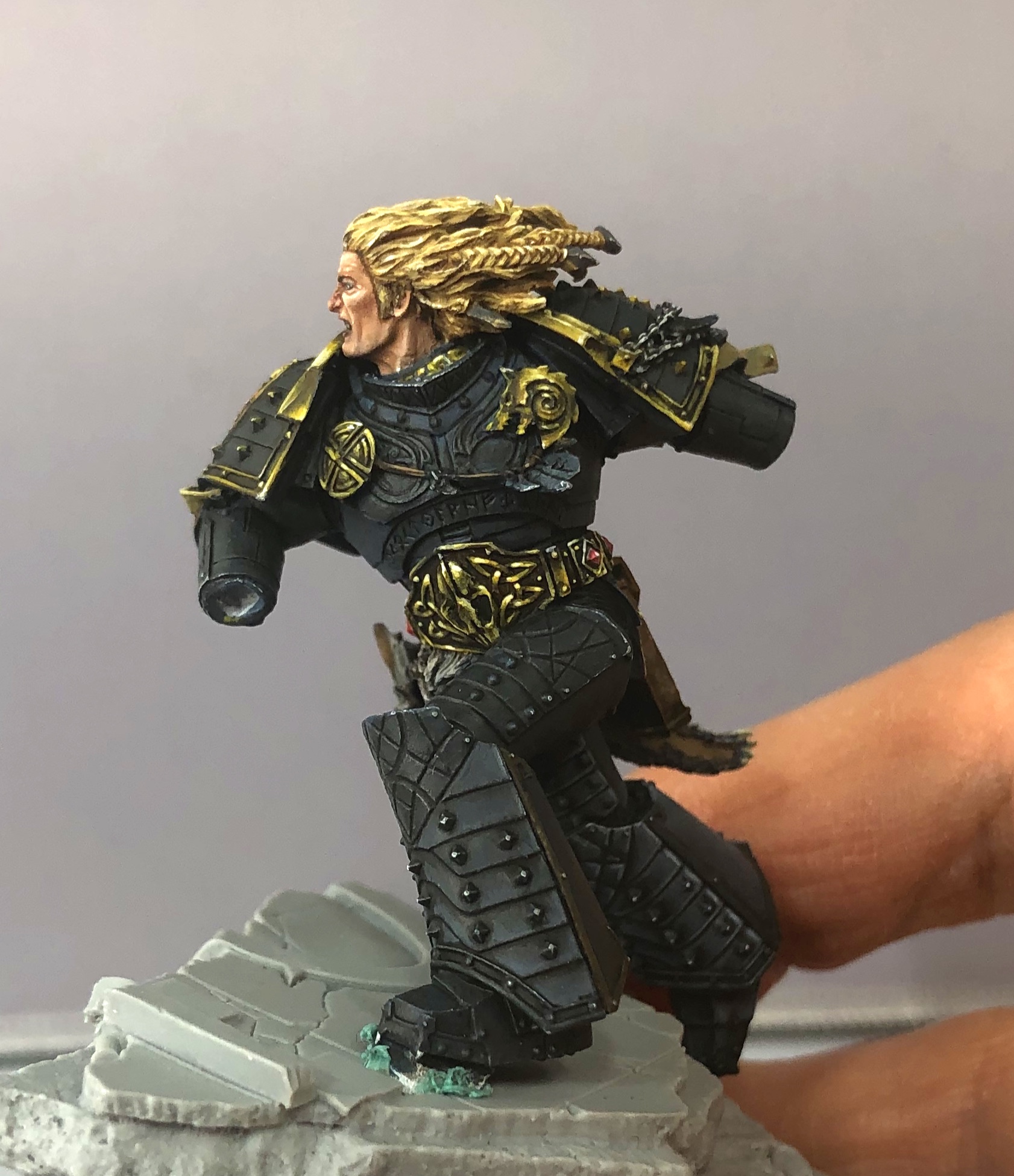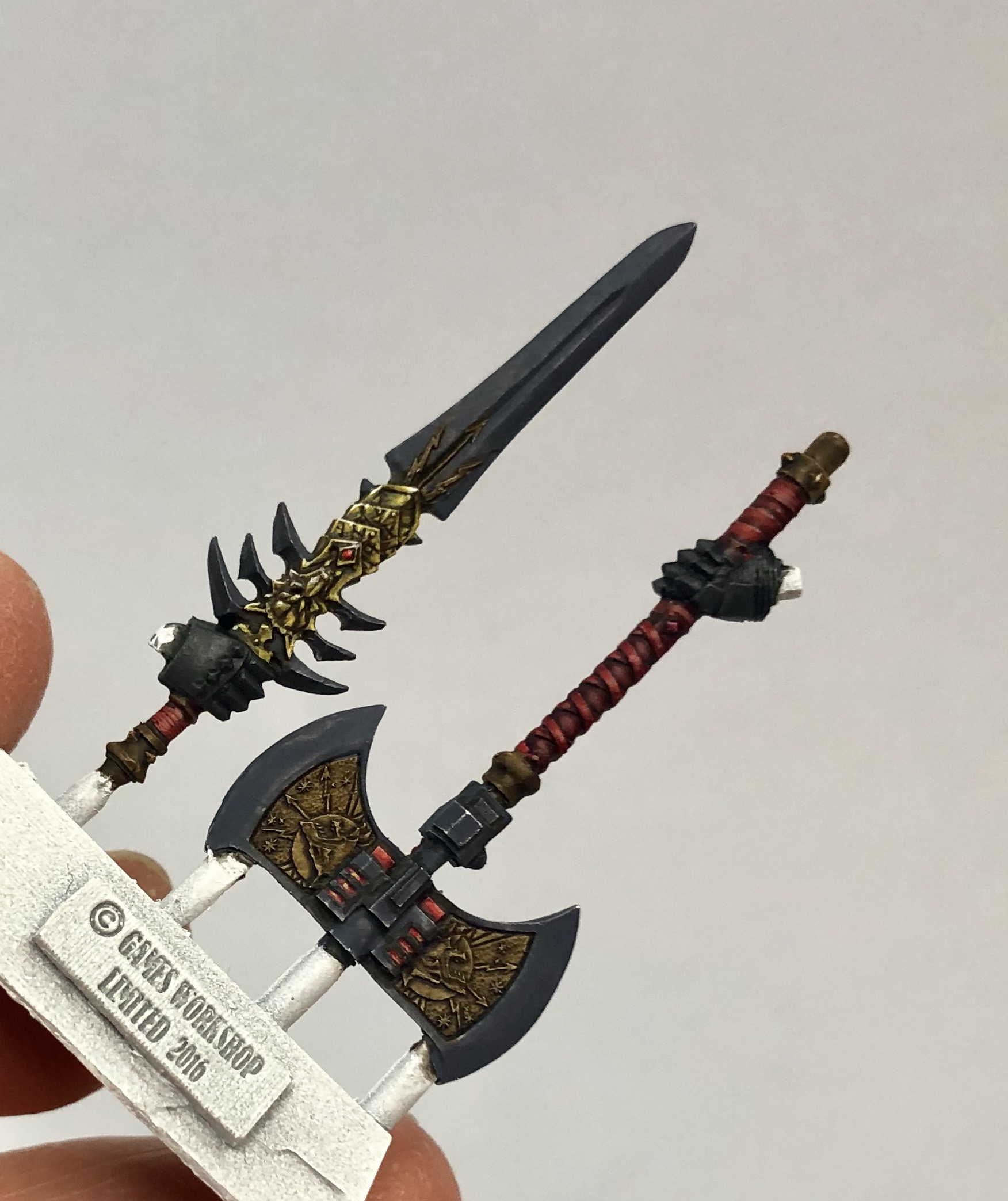Welcome to part two of my Forge World Leman Russ work-in-progress blog! I realized after I looked at my photo collection that I didn’t have too many photos to add, and most of them are about the basing, so this will be shorter than the last one. Here we go!
Here he’s still blue-tacked onto the base, and I’m getting a lot more done on the armor.
I blue-tacked Leman to the base pretty much for the entire period I was painting him. The pillar for the foot to stick in was nice and large, and he was actually quite stable that way. His 40mm base was also a comfortable size for me to hold for longer periods of time, so I didn’t feel the need to stick him on a separate miniature holder.
Here you can see I’m making a lot of progress on the armor. All those little sections took a long time to paint! Since Space Wolves are a bit darker in 30K, I started with a mixture of two Reaper colors, Carbon Grey and Glacial Mist. They’re from our latest Reaper Bones Kickstarter, and aren’t released just yet, but they will be a few months from now. Perks of being She Who Makes the Paint, that I get to use them early! ;)
Carbon Grey is a great charcoal grey color. I wanted something very dark but just light enough that a black wash would work well over it for my friends painting armies and models with lots of black. :) I love grey-blue colors, so Glacial Mist is one of those, very close to a traditional Space Wolf shadow color. From there I just mixed in a bit of white to make higher highlights.
Chest-on shot as I get even more of the armor completed.
Here’s a chest-on shot, which I really feel is his best angle to show off that elaborate armor. Last thing to do was to finish and attach the sword…
Sword attached, and base started! Now he can really murder some traitor Marines…
Sword done! I decided to do the sword in a more traditional steel, which makes it stand out better against the darker armor. Now that Leman himself was done and assembled, it was time to work on his base. Here’s a shot of that a little farther along.
Leman was painted with a total of about ten colors, so you could say that he’s painted in a “limited palette” paint style. When I needed an additional color, I tried to mix it with what I was already using. This technique can help to make your model look like it’s really integrated with the basing. Since I wanted to try not to introduce a lot of extra colors for the basing, everything is done utilizing the colors I used on Leman himself.
You can see this in the faded orange above. I wanted to highlight the Thousand Sons red more, and also to create random energy patterns foreshadowing their imminent fall to Chaos. Instead of grabbing an orange or yellow that I hadn’t previously used, I mixed my gold NMM highlight (Reaper MSP 9303 NMM Gold Highlight, in fact) into my red. This gave me a more muted or faded orange, but I kind of liked that because I didn’t want the base to be so bright that it would distract from Leman.
Smaller gaming base almost completed.
Here’s the smaller gaming base almost done. Now that you know I was mixing my stone colors with the paints I was already using, you can see where the red and yellow play in. The greenish-grey tones are made when grey (which contains black) mixes with the yellow pigments. The purple-blues are the same color I used for shading the lightning axe, the small axe blade on the back of the cape, and the initial cold shading on the cape itself, mixed with the Carbon Grey and Glacial Mist.
Gaming base complete! Almost done…
Leman finally glued down onto his complete gaming base. The only thing left to do was the outer base, which would be the same colors as the gaming one. There wasn’t a big obvious place to carry the red over for the Thousand Sons motif on the front side of it, so I ended up coloring the runes on the columns with touches of the red and orange.
Big Base In Place!
I was able to put more of the red/orange touches on the back where the scarab and Thousand Sons emblem were carved into the stonework.
From above. Love the dynamic composition of the model with the base. Everything done here except the parchment and one column!
DONE!
Leman complete! Achievement unlocked! I hope you’ve really enjoyed seeing the photos and reading the blog. Next up, I have some work to do on Leman’s dire wolf buddies! I’ll be doing an in-depth tutorial on at least one of those for my Patreon (patreon.com/paintingbig), probably with both text and video. Some WIP photos will end up on here, though, never fear. Stay tuned and thanks so much for reading!

































